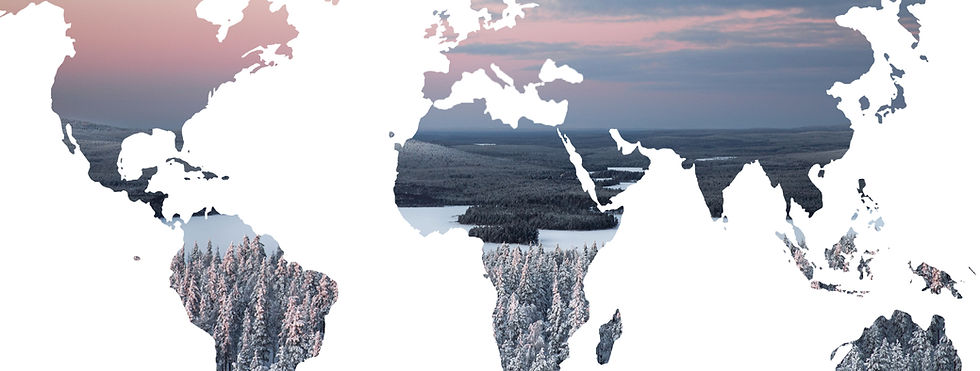Winter Traditions
- Dec 22, 2022
- 4 min read
A look into some of the bizarre winter/ holiday traditions around the world.
Written by: Halle Elder

Many of us here in the United States of America, when thinking about winter traditions, would come up with ideas surrounding Christmas, Hanukkah or Kwanzaa. This could be presents under the tree, sledding down hills, Christmas caroling, spinning the dreidel and exchanging gifts. We are aware of these traditions because they surround us every year, but what do you know about traditions that are celebrated in the winter months from around the world?
Different cultures and different countries celebrate in their own unique ways, but there are some winter traditions that stick out.
Different cultures and different countries celebrate in their own unique ways, but there are some winter traditions that stick out. The following traditions and celebrations showcase some of the most interesting winter traditions from around the world.
Polar Plunge
Before we go too far from home, this tradition is one that occurs right in our backyard. The polar plunge is a winter tradition that is celebrated in parts of the U.S. and Canada, primarily the Northeast and the Midwest. Usually occurring on New Year’s Day, participants of a polar plunge jump into freezing cold rivers, lakes and ponds wearing only their swimsuits. These events are often held for a charity fundraiser or to bring awareness to certain causes. Minnesota’s polar plunge is one of the largest fundraisers for the Special Olympics, and many other states use this tradition to raise money for the Special Olympics as well. Would you try this daring tradition for a good cause?
Shoe Toss
Across the Atlantic, this Christmas tradition from the Czech Republic has the ability to tell one’s future. On Christmas Eve, young, unmarried women perform a winter ritual in which they walk outside their homes and throw a shoe over their shoulder. Legend has it that wherever the shoe points foretells the women's relationship for the next year. If it falls pointing towards the door of their home, it is a sign that the woman will be in a relationship in the next year. Sometimes, it means that she will be married within the year. However, if it points any way but directly at the door, the women will spend the next year single. Depending on the woman's wishes, either option could be a good or bad omen. Would you prefer the shoe be pointing towards the door, or away?
Dongzhi Festival
Christmas is not the only holiday that is celebrated worldwide. Another common winter holiday celebration is the Winter Solstice, which occurs on the shortest day of the year, when the Earth’s pole reaches its maximum distance away from the sun. On this day, an important Chinese festival takes place in countries around east Asia. The Dongzhi Festival (named for a Mandarin term meaning “winter’s extreme”) has its origins in the yin and yang philosophy of Chinese culture. The hope is that as the days grow longer after the winter solstice, the positive, or yang, energy will begin to flow. During this festival, families unite and share in a feast to celebrate the coming days. One of the highlights of the meal is the ear-shaped dumplings, which carry a legend that a physician once took pity on the homeless people in his town and fed them dumplings, preventing their ears from getting frostbite (and inspiring the unusual shape). How will you celebrate the coming shorter days?
Yalda Night
Another celebration of the winter solstice occurs on Yalda Night, which is celebrated primarily in Iran, as well as other Persian-influenced countries like Afghanistan, Azerbaijan and Tajikistan. Yalda translates to “birth” in English, so this night is a symbol of rebirth as the days begin to grow longer after the solstice. This night is one of the most important celebrations of the year for those who celebrate as it has origins in ancient Persia and it is regarded as a celebration in honor of Ahura Mazda, the lord of wisdom. On this night, families gather together throughout the night reading poems to one another and share food and drinks. Some of the most important items on the menu include watermelon and pomegranates, as these two fruits are said to represent the cycle of life. What will you do this winter to promote your own wisdom coming out of the winter season?
Noche de los Rábanos (Night of the Radishes)
Heading back over to the Americas, Noche de los Rabanos is a celebration that occurs in Oaxaca, Mexico which begins on December 23. This three-day festival involves residents of Oaxaca carrying large carved vegetables, specifically oversized radishes. These radishes are carved to look like the Nativity and special symbols of Mexican folklore. The carvings began as a gimmick for vegetable farmers to gain attention from customers at markets, but the finely-carved radishes began to be bought as centerpieces for Christmas dinner. At some point, these oversized carved radishes became so popular that a competition was held to find the best one for the year. Today, the competition brings visitors from far and wide as the residents of Oaxaca parade through their city with their creations. Do you think you could create a veggie masterpiece?
These winter traditions from around the world showcase the amazing diversity of traditions that we have as humans, while also showing that we all want to celebrate in some way. Whether it is familiar Christmas traditions, freezing endeavors, celebrations of the coming longer days, or vegetable centerpieces, there are so many different ways to celebrate. Each country, culture and person has their own traditions and celebrations, but it is always fun to learn about how others celebrate as well. I wish you all the best of luck finding your winter traditions this year!






